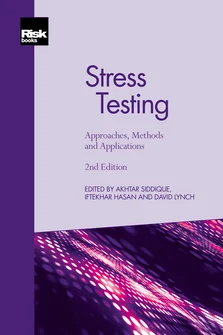An Alternative Approach to Stress Testing a Bank’s Trading Book
Sean D Campbell, Amy Lorenc and Paweł J Szerszeń
Foreword
Introduction
Response to Financial Crises: The Development of Stress Testing over Time
Stress Testing and Other Risk Management Tools
Econometric Pitfalls in Stress Testing
Stress-testing applications of Machine Learning Models
Four Years of Concurrent Stress Testing at the Bank of England: Developing the Macroprudential Perspective
Stress Testing for Market Risk
The Evolution of Stress Testing Counterparty Exposures
Liquidity Risk: The Case of the Brazilian Banking System
Operational Risk: An Overview of Stress-testing Methodologies
Peacetime Stress Testing: A Proposal
Stress-test Modelling for Loan Losses and Reserves
A New Framework for Stress Testing Banks’ Corporate Credit Portfolio
EU-wide Stress Test: The Experience of the EBA
Stress Testing Across International Exposures and Activities
The Asset Market Effects of Bank Stress-test Disclosures
An Alternative Approach to Stress Testing a Bank’s Trading Book
Determining the Severity of Macroeconomic Stress Scenarios
Governance over Stress Testing
A number of large bank holding companies (BHCs) are subject to a market risk stress test that subjects their trading book exposures to a market shock. This chapter proposes a simple and transparent trading book stress model that is motivated by standard risk management measurement approaches (ie, value-at-risk, VaR), and only requires data on a bank’s trading profit and loss (P&L) at the asset class level. The model makes use of variables that are already articulated in the macroeconomic stress scenario and does not require the articulation of a separate market shock. Finally, by design, the proposed stress model always produces losses and the relative size of the stress losses can be calibrated by adjusting one of several tuning parameters. Bank P&L data is used to estimate stress losses that would have resulted in the 2016 stress test had the proposed model been employed.
The stress-testing programme considers the mark-to-market losses borne by trading book assets for large US BHCs. The importance of trading and counterparty stress losses vary significantly across firms, and these losses account for over 50% of all stress losses at two banks and over 20% for three banks
Copyright Infopro Digital Limited. All rights reserved.
As outlined in our terms and conditions, https://www.infopro-digital.com/terms-and-conditions/subscriptions/ (point 2.4), printing is limited to a single copy.
If you would like to purchase additional rights please email info@risk.net
Copyright Infopro Digital Limited. All rights reserved.
You may share this content using our article tools. As outlined in our terms and conditions, https://www.infopro-digital.com/terms-and-conditions/subscriptions/ (clause 2.4), an Authorised User may only make one copy of the materials for their own personal use. You must also comply with the restrictions in clause 2.5.
If you would like to purchase additional rights please email info@risk.net











